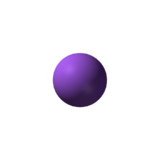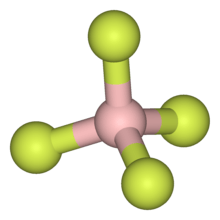Sodium tetrafluoroborate
Sodium tetrafluoroborate is an inorganic compound with formula NaBF4. It is a salt that forms colorless or white water-soluble rhombic crystals and is soluble in water (108 g/100 mL) but less soluble in organic solvents.[1]
| |||
| Names | |||
|---|---|---|---|
| Other names
sodium fluoroborate, NaBF4 | |||
| Identifiers | |||
3D model (JSmol) |
|||
| ChemSpider | |||
| ECHA InfoCard | 100.033.931 | ||
PubChem CID |
|||
| UNII | |||
CompTox Dashboard (EPA) |
|||
| |||
| |||
| Properties | |||
| NaBF4 | |||
| Molar mass | 109.794 g/mol | ||
| Density | 2.47 g/cm3 | ||
| Melting point | 384 °C (723 °F; 657 K) | ||
| Related compounds | |||
Other cations |
Nitrosonium tetrafluoroborate | ||
Except where otherwise noted, data are given for materials in their standard state (at 25 °C [77 °F], 100 kPa). | |||
| Infobox references | |||
Sodium tetrafluoroborate is used in some fluxes used for brazing and to produce boron trifluoride.[2]
Preparation
Sodium tetrafluoroborate can be prepared by neutralizing tetrafluoroboric acid with sodium carbonate or sodium hydroxide.[3]
- NaOH + HBF4 → NaBF4 + H2O
- Na2CO3 + 2 HBF4 → 2 NaBF4 + H2O + CO2
Alternatively the chemical can be synthesized from boric acid, hydrofluoric acid, and sodium carbonate:[2]
- 2H3BO3 + 8HF + Na2CO3 → 2NaBF4 + 7H2O + CO2
Reactions and uses
On heating to its melting point, sodium tetrafluoroborate decomposes to sodium fluoride and boron trifluoride:[4]
- NaBF4 → NaF + BF3
It is a source of tetrafluoroborate anion, which is used in organic chemistry for the preparation of salts. Sodium tetrafluoroborate can be used for synthesis of ionic liquids, where tetrafluoroborate is the anion.
References
- Milne, G. W. A (2005-07-11). "Gardner's Commercially Important Chemicals: Synonyms, Trade Names, and Properties". ISBN 9780471735182. Cite journal requires
|journal=(help) - Brauer, Georg (1963). Handbook of Preparative Inorganic Chemistry Vol. 1, 2nd Ed. New York: Academic Press. p. 220 & 222. ISBN 978-0121266011.
- Eagleson, Mary (1994). "Concise Encyclopedia Chemistry". ISBN 9783110114515. Cite journal requires
|journal=(help) - Richard j. Lewis, Sr (2008-07-14). "Hazardous Chemicals Desk Reference". ISBN 9780470334454. Cite journal requires
|journal=(help)

